Washington Post features an alley dwelling renovation in LeDroit
How do you convert a rundown carriage house into a compact apartment? One LeDroit Park resident did it with $50,000 and some elbow grease. The converted unit, which the owner rents on airbnb, is nestled in the quiet alley that connects Fourth and Fifth Streets just south of T Street.
I’m friends with the owner and he gave me a tour as he was starting the renovation two years ago. It’s great to see such a drastic transformation. Read the full story in the Washington Post.
Weekend Events
There are two interesting events going on tomorrow:
Masjid Muhammad Community Open House
Masjid Muhammad is the mosque at 1519 Fourth Street NW in Shaw. The mosque is hosting an open house tomorrow from 11 am to 4 pm.
Eight Annual D.C. Truck Touch
The D.C. Government is hosting its annual “truck touch”, an event where residents (especially kids!) get to sit in firetrucks, touch the police helicopter, watch DC Water’s sewer robot in action, gaze at snow plows, peer under street sweepers, and much more.
The Truck Touch is tomorrow from 8 am to 1 pm at Lot 7 at RFK Stadium. View some photos I took of the 2010 Truck Touch.
Neighbors to show their support for the market after it was robbed

LeDroit Park residents plan to show support for the LeDroit Park Market (1901 4th Street NW) after it was robbed on Friday at 8:15 pm. The armed, masked robber made off with less than $400 in cash and undoubtedly terrified the two women who were staffing the store at the time.
To show our support for the store, which reopened within the past year under new management, the LeDroit Park Civic Association is asking neighbors to stop by on Wednesday, March 25th from 7 pm to 9 pm.
Your favorite neighborhood blogger will be there too!
Is Howard University in financial trouble?
Over the past few months, reports have trickled in warning about Howard University’s fiscal health. The news is not good. The school’s enrollment had dropped, its annual Congressional appropriation has fallen, and the hospital is furloughing workers to make up for large losses. On the bright side, Howard’s capital improvement program is underway and several cranes tower over three active construction projects on the campus (more on that later).
As for fiscal issues, the first warning came in June, when a Howard University trustee warned, “Howard will not be here in three years if we don’t make some crucial decisions now.” Whether the trustee was exaggerating Howard’s fiscal straits due to internal politics remains unknown, but a potential sequester of the university’s Congressional appropriation adds to the unease.
Since its founding in 1867, Howard has received an annual appropriation from Congress much the way state universities receive appropriations from their state legislatures. The appropriation has remained steady over the past few years, but sequestration is expected to reduce the amount. Federal funding accounts for a sizable 27% of the university’s operating budget, meaning any change will be noticeable.
Furthermore, the recession, which hit black Americans especially hard, is often cited as a major factor contributing to last year’s 5% enrollment decline, further depriving the university of tuition revenue. Tuition for the 2013-14 academic year is set for $22,783, excluding housing, a difficult stretch for most families.
In June the university announced it would layoff 75 employees and earlier this month, the hospital announced it will furlough 1,700 staff for eight days. The hospital has suffered a sharp decline in patients and revenue.
Money problems are nothing new at Howard. In fact, tight university finances are a theme that appears in The Black Apollo of Science, the biography of Ernest Everett Just, a 1920s and ’30s Howard biology professor and LeDroit Park resident. The university has survived tough times before and it is rare for large universities in the U.S. to shut down.
Some of the bad news is more than just financial. Late last month, news leaked that the university and its development partner had parted ways on the Howard Town Center project, further delaying the mixed-use development project the university has been planning for years.
Lift every crane and build
But there’s good news, too! Visit LeDroit Park’s newest Capital Bikeshare station and you’ll spot the cranes that tower over the Howard campus. In fact, the university is currently constructing three new buildings: two new dorms on 4th Street and an interdisciplinary STEM research building at Georgia Avenue and W Street.
The two dorms at 4th and College Streets NW and 4th and W Streets NW are part of the university’s plan to improve and increase on-campus housing. By making 4th Street NW a residential spine, the university hopes to keep its students in newer buildings physically close to academic buildings. The proximity is expected to boost academic performance and the newness of the housing is expected to attract top-performing students.
Here is a photo of the new dorm now under construction at 4th and College Streets NW:

When finished:
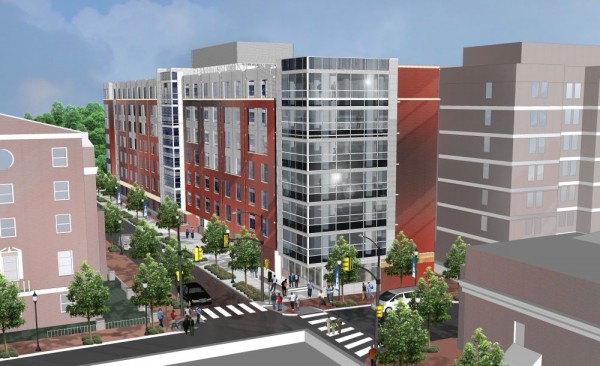
Design of the new Howard University dorm at 4th and College Streets NW.
Here is a photo of the new dorm now under construction at 4th and W Streets NW:
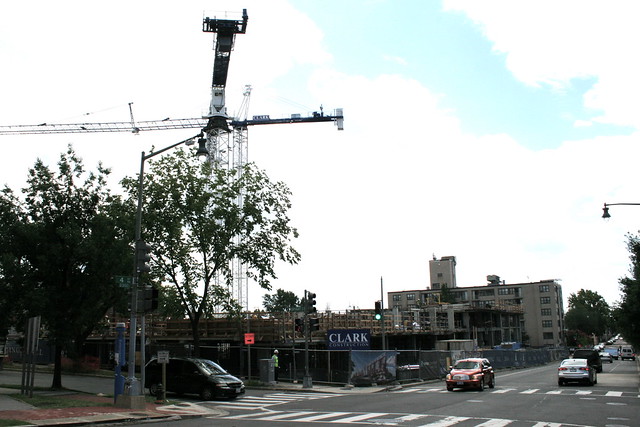
When finished:
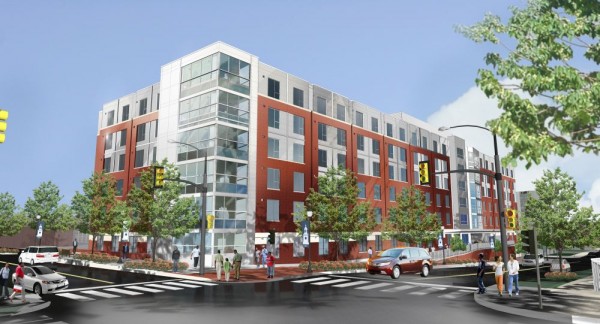
Design for the new Howard dorm at 4th and W Streets NW
At Georgia Avenue and W Street, Howard is constructing a new building for STEM research. The new high-tech facility is expected to boost the university’s research profile and its ability to win research grants that require advanced research facilities. The LeDroit Park Civic Association supported the zoning relief necessary to build this building.
When finished:
Though the university’s fiscal woes make headlines, several important capital improvements are well underway.
Street names changed in 1890

Two years ago we wrote about the old street names for LeDroit Park. Finding out just when the name change occurred is hard to pin down. Different sources, from address directories to newspaper articles, refer to old names and new names during the same period of time.
The mystery is closer to resolution, however, as we found what we believe to be the earliest reference to the name change:
New Names for Le Droit Park Streets.
Washington Post
July 31, 1890The names of the streets in Le Droit Park have been changed as follows: Le Droit Park avenue to Second street, Harewood avenue to Third street, Linden street to Fourth street, Larch street to Fifth street, Juniper street to Sixth street, and Maple avenue to T street.
There appears to be an error in the article as ‘Le Droit avenue’ never actually had ‘Park’ in its name.
LeDroit Park Market Robbed
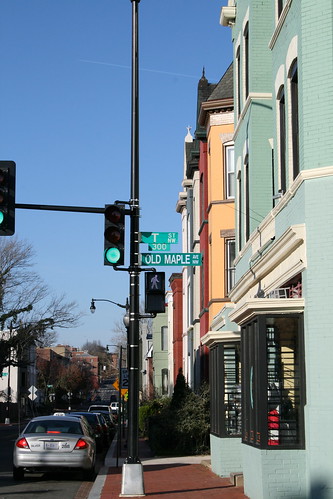 Simon’s store, the LeDroit Park Market at Fourth and T Streets NW was robbed earlier this afternoon. The suspect is described as a black man, 5′ 6″ to 5′ 7″, bearded, and wearing a green shirt, white sunglasses, a dark colored hat, blue jeans with black shoes. The neighborhood-funded surveillance camera placed on Simon’s store may have caught a glimpse of the suspect.
Simon’s store, the LeDroit Park Market at Fourth and T Streets NW was robbed earlier this afternoon. The suspect is described as a black man, 5′ 6″ to 5′ 7″, bearded, and wearing a green shirt, white sunglasses, a dark colored hat, blue jeans with black shoes. The neighborhood-funded surveillance camera placed on Simon’s store may have caught a glimpse of the suspect.
When Simon opened his second business, Cookie’s Corner at the corner of Second and Elm Streets NW, some decried the presence of bullet-proof glass at the counter. Does this latest robbery vindicate that decision?
How LeDroit Park Came to be Added to the City
The following is a Washington Times article from 1903. The article explains some of the early history of the neighborhood and even includes three photos, the first of which was misidentified as Fifth Street, though we have actually matched it up with Second Street. We have included a few links to related information.
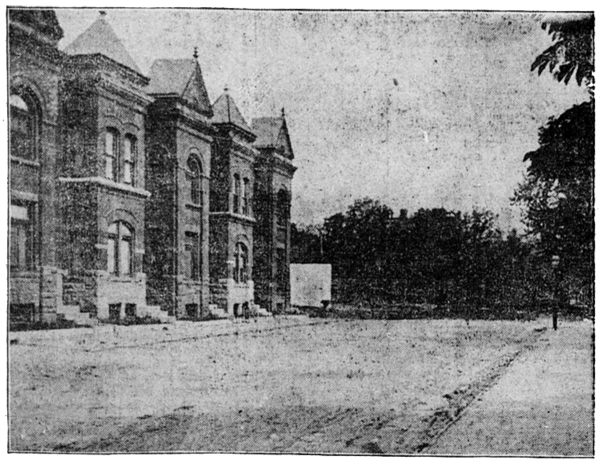
Second Street opposite the Anna J. Cooper House.
HOW LE DROIT PARK CAME TO BE ADDED TO THE CITY
Washington Times
Sunday, May 31, 1903For Many Years the Section of Washington Known by That Name Had Practically Its Separate Government and Had All the Characteristics of a Country Town, Although Plainly Within the Boundary Limits. * * *
In that portion of Florida Avenue between Seventh Street and Eighth Streets northwest where the street cars of the Seventh Street line and the Ninth Street line pass over the same tracks, thousands of passengers are carried every day, and probably but a few if any realize the fact that they are passing over a road older than the organization of the city, a road that dates back to the Revolutionary period— the Bladensburg Road, which connected Georgetown with Bladensburg before the location of the National Capital was determined.
The Map on the Wall.
If the people passing this point will note the little frame building occupied by a florist, 713 Florida Avenue northwest, they will observe that in front of these premises and fastened to the blacksmith shop adjoining is a goodly sized signboard on which is painted an old map of this section and showing the intersection of the old Blandensburg Road and Boundary Street, now known as Florida Avenue. From this map it is seen that Seventh Street Road [now Georgia Avenue] intersects Boundary Street and the old Bladensburg Road at a point about 100 feet east of where the two roads join at an acute angle, and glancing along the lines of Boundary Street and the north lines of some buildings which have been erected in this angle we easily see the direction of the Bladensburg Road and discover that the small building 713 Florida Avenue northwest marks the spot where the Bladensburg Road deflected from Boundary Street and bore off in a northeasterly direction toward Bladensburg.
Once Part of Jamaica Vacancy.
The map referred to is said to be a portion of [the estate named] Jamaica and and Smith’s Vacancy, but if we examine the plats in the office of the Surveyor of the District we will hardly find on file any plats of those sections, but may learn that Le Droit Park was once part of Jamaica and Smith’s Vacancy and possibly a portion of [the estate named] Port Royal. Prior to the cession of the territory now included in the District from Maryland the land known as Jamaica was owned by one Philip R. Fendall, of Virginia. He conveyed this tract of 494 acres on the 12th day of January, 1792, to Samuel Blodgett, jr., of Massachusetts, and from this point the title of the land can be traced down to the present time.
The names attached to the different vacancies establish the names of the various owners of lands adjoining Bladensburg Road at the time it was abandoned as a thoroughfare and taken up as a portion of the farms in that section, and the presence of this old road accounts for some of the peculiar lines in some of the northern boundaries of some of the lots in Le Droit Park. This road crossed Second Street at a point north of Elm Street here. The old plats show Moore’s Vacancy. The road finally joined the present road to Bladensburg at a point where the sixth milestone of the norther line of the District was located.
It is probable that this peculiarly natural boundary of some of the lands which afterward became Le Droit Park may have had something to do with the strange lines which are found in the streets of that suburb, although it was not the intention at the time that Le Droit Park was subdivided to have the streets conform with the city streets.
Site of Campbell Hospital.
During the civil war the territory now contained in Le Droit Park was used as the site of Campbell General Hospital, one of the important hospitals near Washington. The hospital comprised some seventeen separate wooden buildings, erected in the form of a hollow square, with the central portion divided into irregular spaces by buildings cutting across the inclosure and connecting the outside buildings.
The larger dimension of this hospital was fro north to south, and extended from Boundary Street, now known as Florida Avenue, on the south, to the land occupied for many years as a baseball park, situated south of Freedman’s Hospital, and designated on some of the old maps as Levi Park. From east to west the hospital covered the ground from Seventh Street to what is now known as Fifth Street in Le Droit Park, and it is possible that a portion of the space between Fifth Street and Fourth Street was also included in the hospital inclosure.
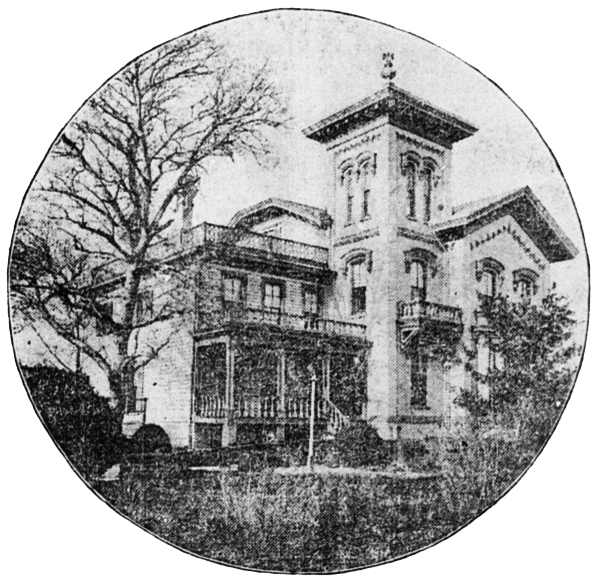
The McClelland Residence.
At this time there were only two dwellings in the tract known afterward as Le Droit Park— the McClelland and Gilman homestands. Each included about ten acres of land used for grazing and garden purposes. The McClelland property and the Gilman property were divided by a row of large oak trees which were situated about fifty feet apart and continued from Florida Avenue, then Boundary Street, to the northern line of the park.
[See the following 1861 map, a map we extolled several months ago:
To the east of the Gilman tract was a narrow strip of land known as the Prather tract. East of this was Moore’s Lane, now Second Street, and still to the east was the tracts of the Moores, George and David, covering the territory as far east as the present location of Lincoln Avenue [now Lincoln Road], on which was located Harewood Hospital, another hospital of considerable note during the civil war.
T.R. Senior, who was commissary at Campbell Hospital, returned to the city some twelve years after the war closed and purchased a residence at the corner of Elm and Second Streets, where he now resides. Members of the family of David McClelland now occupy the old homestead on Second Street.
Following the close of the war it became necessary to provide for such of the freedmen as were in need of assistance. Campbell General Hospital was occupied by the freedmen until August 16, 1869, when the patients were transferred to the new Freedman’s Hospital, which has been erected in connection with Howard University.
The property upon which Freedman’s Hospital stands consisted of a tract of 150 acres and was purchased from John A. Smith. In April, 1867, Howardtown was laid out and soon after some 500 lots were sold, and at this time it seems that the idea was conveyed that streets would be opened to the south through the Miller tract. In April, 1870, the Howard University purchased the Miller tract, and laid out streets to connect the streets of Howardtown with the city streets, and a little later built four houses on the line of what is now known as Fourth Street and in 1872 subdivided the Miller tract, but for some reason the plat was not recorded.
In 1873 the Miller tract was sold by Howard University to A[ndrew] Langdon, and a short time afterward A[mzi] L[orenzo] Barber, formerly secretary of Howard University, became associated with Langdon and hs partner, and by arrangements with D[avid] McClelland, all of the three tracts known as the Miller tract, the McClelland tract, and the Gilman tract were united and subdivided, and in June, 1873, a subdivision known as Le Droit Park was placed on record in the surveyor’s office. A subsequent plat was filed some eighteen months later, in which the proprietors of the subdivision declared it to be their purpose and intention to retain and control the ownership of all the streets platted, and the right to inclose the whole or any portion of the tracts or tract included in the subdivision and to locate and control all entrances and gates to the same.

During the autumn of 1876 A. L. Barber & Co. commenced the erection of fences across the north line of Le Droit Park, and from this time until August, 1891, fences were maintained along the northern line of the park. From 1886 to 1891 frequent fence wars were in operation. The fence across what is now Fourth Street would be removed by one party, and the opposing party would secure an injunction and restore it. This mode of procedure was repeated at various times until in 1901 a compromise verdict was agreed upon by the two factions and the fence was removed, Fourth Street was improved north of the park, and the streets of the park passed into the control of the city after a period of some eighteen years of private ownership.
The organization of Le Droit Park, under the limitations of the plat filed in 1873, was a peculiar experiment, that of the founding of an independent suburb adjoining the city. the southern line of the park was inclosed with a handsome combination iron and wood fence, some of which may now be found on the southern line of the McClelland property. Buildings were erected with plenty of room around them, and during the period from 1873 to 1885 the larger part of the buildings were planned and erected by James H. McGill. Double houses were quite common, but it was not until 1888 that such a thing as a row of houses were known in the park.
Before control of the streets was surrendered to the city the conditions existing in the park resembled closely those found in small country towns. Many of the inhabitants owned cows, which were pastured upon the vacant lots; the women “went a-neighboring,” and the social life savored strongly of a village, and yet it was near the city. The express and telegraph messengers, however, always collected of residents an extra fee for the reason that they lived out of the city.
With the opening of the streets and the introduction of street cars the park soon lost its former characteristics and became part of the city with all of its advantages and disadvantages. The opening of Rhode Island Avenue [from Florida Avenue eastward] spoiled in a measure the former beauty of the McClelland and Gilman homesteads, although there is still much more ground remaining in both of these old tracts that many people would care to own. The opening of Fifth Street will, to some extent, divide the traffic which now finds a way through Fourth Street. Sixth Street ends at Spruce Street [now U Street], and further progress seems barred by the residence, 601 Spruce Street, and there seems no immediate chance of the extension of Third Street above its present limit [at V Street??], where progress is barred by a high fence decorated with the advertisement of a prominent firm.
Former Familiar Street Names.
The old names of the streets of the park, such as Harewood Avenue [now Third Street], Maple Avenue [now U Street], Moore’s Lane [later Le Droit Avenue, then Second Street], Linden Street [now Fourth Street], Larch Street [now Fifth Street], Juniper Street [now Sixth Street], and Bohrer Street [still extant], are nearly forgotten, and have passed away with the fence and its period. The names of the city streets have taken their places, and with the growth of the population the country life and country scenes have given way to those of the city.
Casino Conviction
Last summer reports surfaced of a gambling house on Fourth Fourth Street between Elm Street an Oakdale Place. After a months-long investigation, the MPD finally swooped in and arrested two residents of the house in late January. After the arrest the MPD informed the neighborhood that they also found sound-proofing material attached the interior walls to reduce the noise emanating from the house. Whether this was out of respect for the neighbors or fear of getting caught, one cannot know.
Last month the police and U.S. Attorney obtained a conviction and Lt. Alberto Jova informs us that an eviction is also pending.
Snow Mound
Unlike Metro, Howard University Hospital must stay open no matter the weather. As such the groundskeepers are quick to remove snow the moment the first flake hits the ground. The employee parking garage on the block bounded by Fourth Street, V Street, Fifth Street, and Oakdale Place also needs its top level cleared of snow. But where does the snow from the top level go? Well, over the edge it seems.
Going for a Record
The record snow that accumulated this weekend brought us out to snowball fights and sledding in Meridian Hill Park. With few stores open and few roads passable, Saturday was a true holiday in the old-fashioned sense.
Howard University Hospital’s groundskeeper was out in heartbeat clearing the hospital’s sidewalks while contractors cleared the hospital’s parking lot. Pretty impressive!
Neighbors dug their cars out of snow and the usually busy Florida Avenue carried more pedestrians then automobiles. The District government sent numerous plows along U Street and Florida Avenue, largely neglecting (understandably) the quiet streets of LeDroit Park.
You didn’t need a 4×4 to get around this weather. These two girls found that a daddy-powered sled was the most convenient form of transportation.
In Dupont Circle, hundreds of people gathered for a snowball fight. We caught the end of it:
Is a white Hummer camouflaged when it’s in the snow? These snowballers were able to spot and pelt it.
This Suburban sped away as soon as the light turned green.
For cars in LeDroit Park, Fourth and Fifth Streets are passable, but the east-west streets are better left to the four-wheel-drives.
More snow is expected Tuesday night and during the day on Wednesday. Were Pres. William McKinley still alive today, he would not only argue the merits of a gold standard with Rep. Ron Paul, but would also scoff at this relative “dusting”. Though we’ve recorded 45 inches so far this winter, the winter of 1898-99, during McKinley’s administration, set the city’s record, dumping a total of 54.4 inches on the capital!
If you’re tired of the snow, be glad you don’t live in Québec City, which suffers 124 inches of snow each winter… on average!

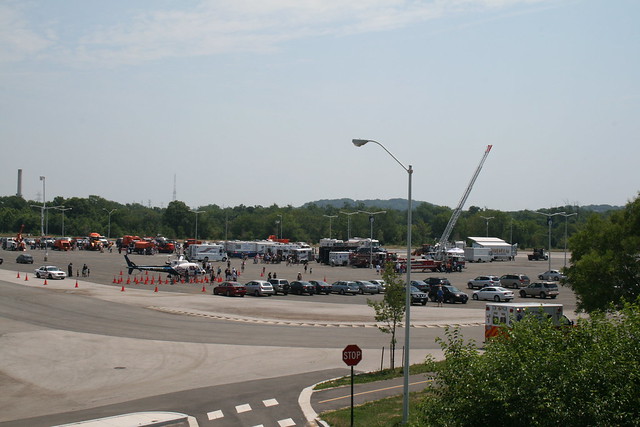
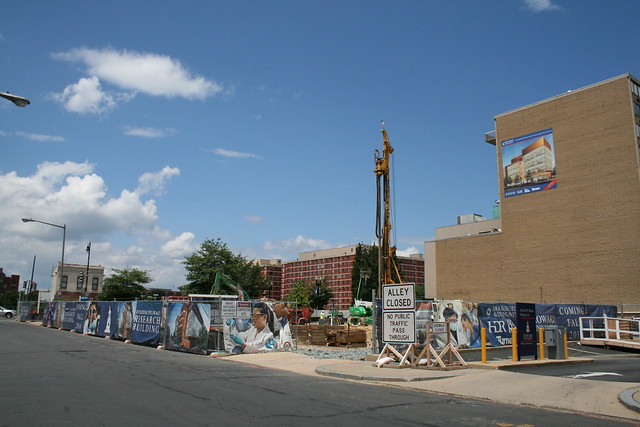
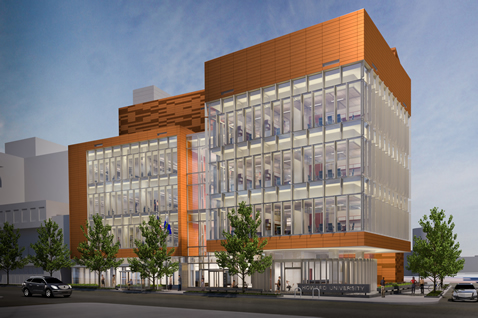
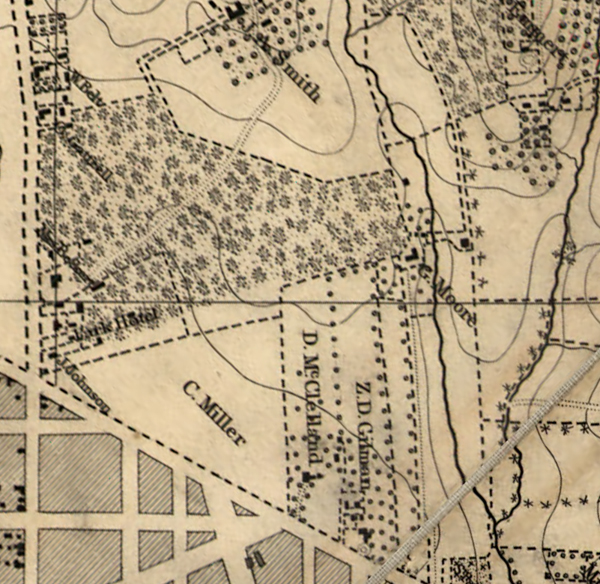
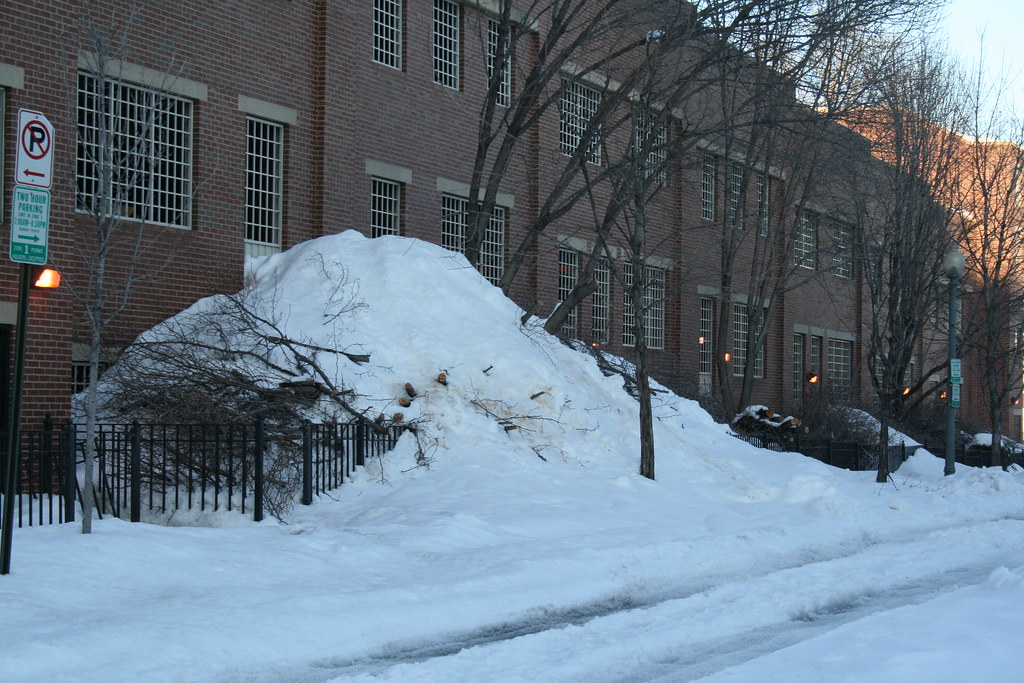
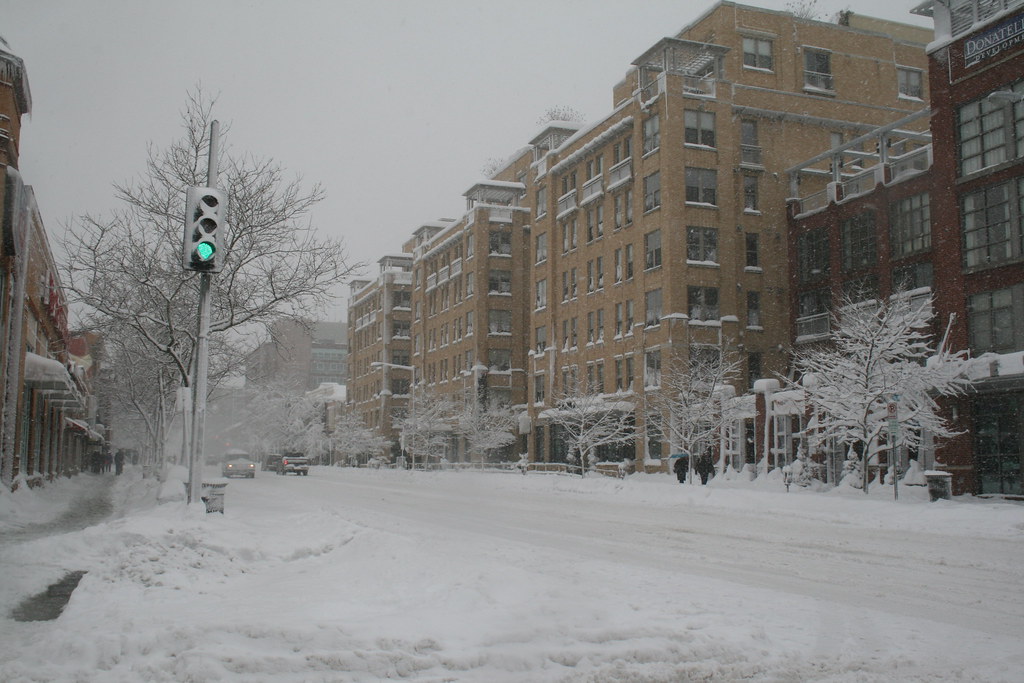
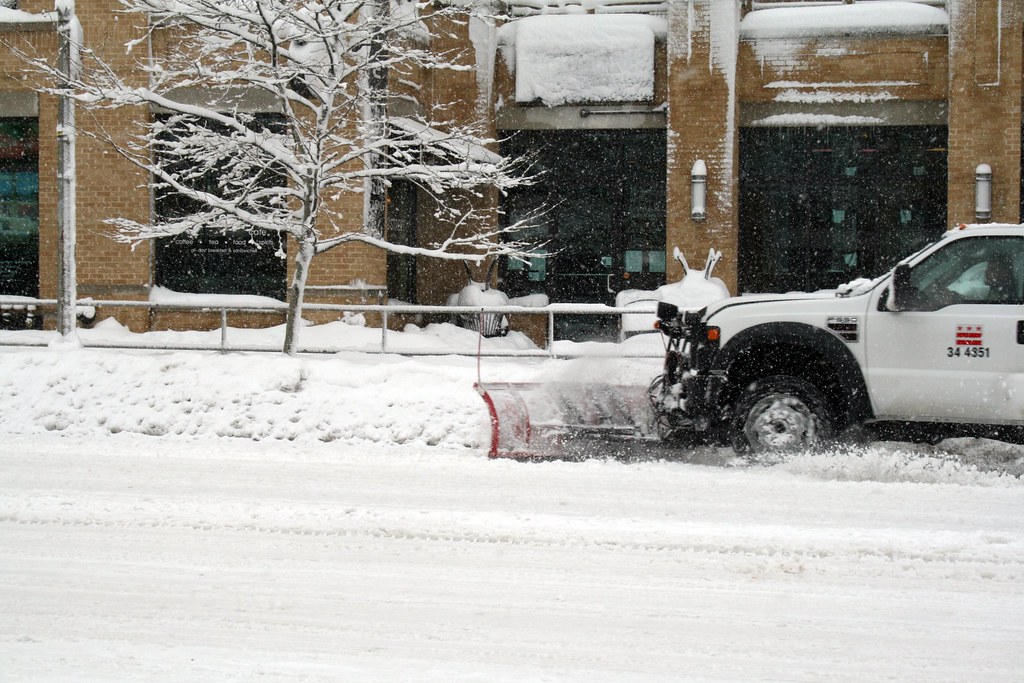
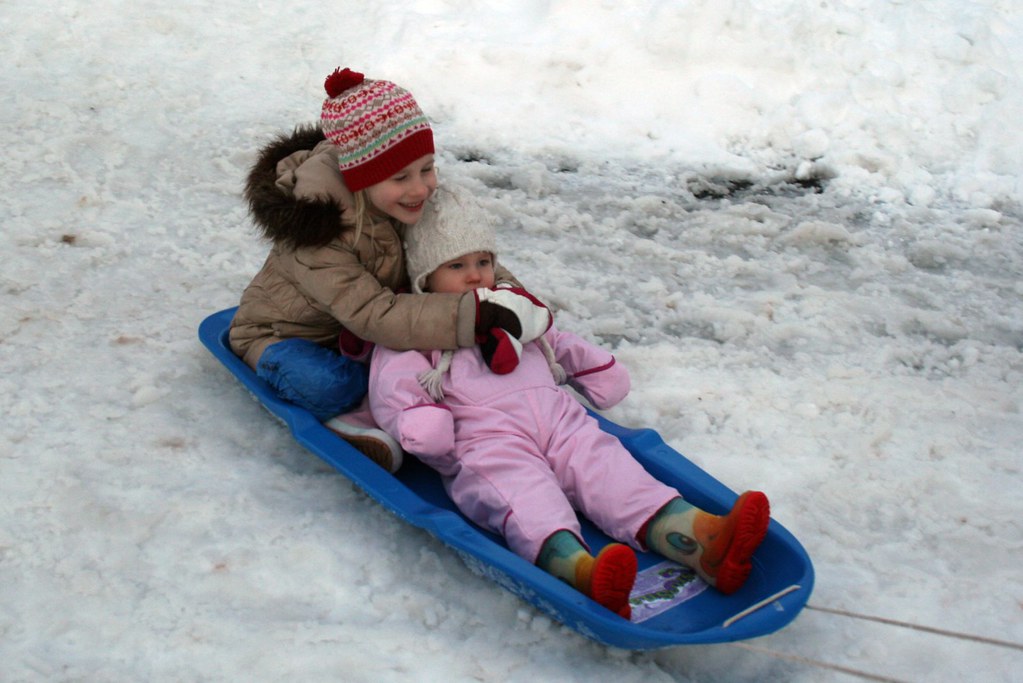
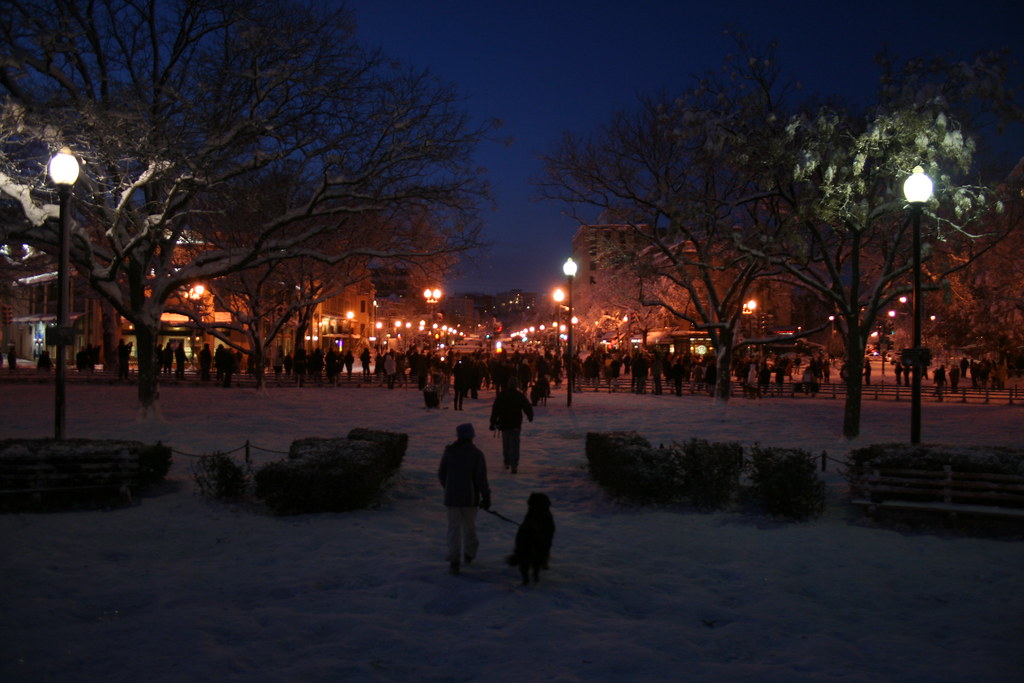
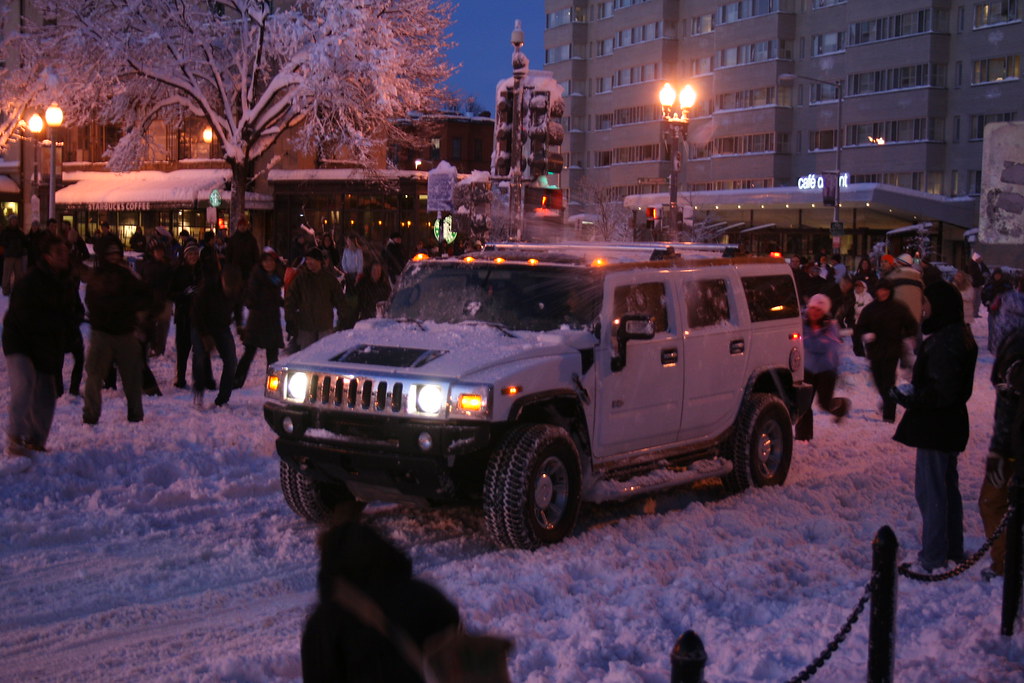
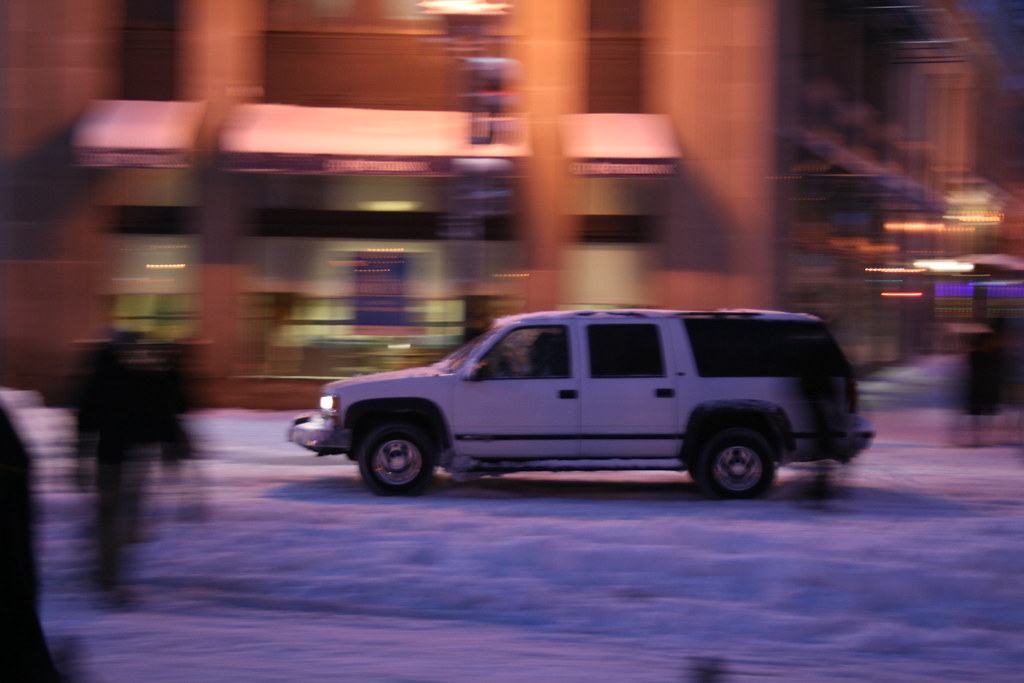






Recent Comments